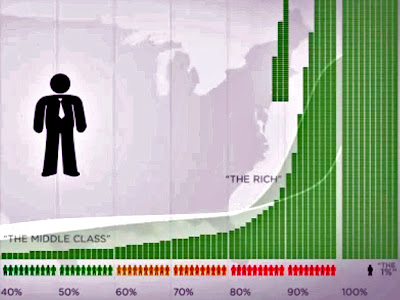by Brian T. Lynch, MSW
Wealth disparity has a profound, relativistic impact in human societies and this is worth understanding. Even in the most egalitarian societies where everything is shared, there are subtle differences in the distribution of goods and services. These small differences convey powerful social messages that are keenly felt by all its members. These messages impact social interactions and the social order. Wealth distribution has powerful symbolic meaning in every society, large or small, rich or poor.
 |
Wealth Disparity is Worse Than You Think - Business Insider
|
When the actual material differences in wealth are subtle, the
costs or benefits conferred by wealth distribution are limited to social
perceptions and their impact on social order or governance. These material
differences are not existential threats to the socially disadvantaged. However,
as the actual material differences between members of a society grow, the
scarcity of essential resources for some may follow. This becomes consequential
as it increased the efforts needed to assure survival. It introduces more
uncertainty and a loss of personal control. The distribution-induced disparity can
grow to the point where it can even become life-threatening. Additionally, the
social power differential grows to the point where social relationships between
the advantaged and disadvantaged can become exploitive and extractive.
Under conditions of extreme wealth disparity, there are physical and psychological impacts on both the powerful and less
powerful. The Socially disadvantaged undergo significant stress and will
exhibit all the symptoms and conditions induced by chronic stress (alcoholism, drug
abuse, depression, maladaptive behaviors, obesity, child abuse, poor health
outcomes, etc.). What is important to understand is that it is the disparity in
wealth that induces social stress, not the absolute measure of wealth. Extreme
wealth disparity becomes pathological in all societies, both rich or poor. This
appears to have been true throughout history. Evidence of the corrosive effects
of social disparity has even been demonstrated in research studying the impact
of dominance on subordinate primate populations, so this appears to be a
natural phenomenon.
Extreme wealth disparity is a threat to society. This fact is
underappreciated by many. And distribution-induced shortages don't need to be
at starvation levels before reaching critical mass, especially in wealthy
countries like ours. Pundits have used this starvation metric or comparisons of
our poverty to that found in poor countries to dismiss the current threat we
face from rapidly growing wealth disparity. A better measure of our social instability
is the health and welfare of the nation's poor. The ranks of the poor are
growing and their welfare is rapidly deteriorating. Here we find a conspiracy
of silence in the mainstream press. The symptoms of poverty-induced stress
have been reinterpreted as moral weaknesses and personal failings for which the
poor have no one but themselves to blame. Both the unfair distribution of
current wages and the redistribution of wealth through taxes to assist the poor
are almost taboo subjects. To raise these issues is to be accused of inciting
class warfare, which is exactly what has been raging for decades to bring us to
this point.
No comments:
Post a Comment
Please feel free to comment or make suggestions